
Robert Leroy Johnson was an American blues musician and songwriter. His landmark recordings in 1936 and 1937 display a combination of singing, guitar skills, and songwriting talent that has influenced later generations of musicians. Although his recording career spanned only seven months, he is recognized as a master of the blues, particularly the Delta blues style, and one of the most influential musicians of the 20th century. The Rock and Roll Hall of Fame describes him as perhaps "the first ever rock star".

Eric Johnson is an American guitarist, vocalist and composer. His 1990 album Ah Via Musicom was certified platinum by the RIAA, and the single "Cliffs of Dover" won the Grammy Award for Best Rock Instrumental Performance.

Heritage Guitar is an American musical instruments manufacturer company based in Kalamazoo, Michigan. The company produces a range of electric guitars that includes hollow-body models.

Robert Lockwood Jr. was an American Delta blues guitarist, who recorded for Chess Records and other Chicago labels in the 1950s and 1960s. He was the only guitarist to have learned to play directly from Robert Johnson. Robert Lockwood was one of the first professional black entertainers to appear on radio in the South, on the King Biscuit Time radio show. Lockwood is known for his longtime collaboration with Sonny Boy Williamson II and for his work in the mid-1950s with Little Walter.
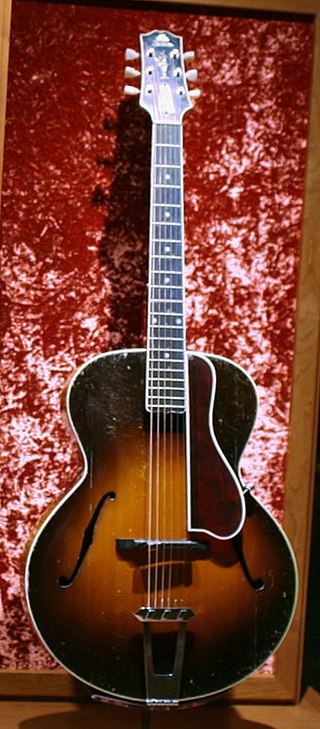
The Gibson L-5 is a hollow body guitar first produced in 1923 by the Gibson Guitar Corporation, then of Kalamazoo, Michigan. The first guitar to feature F-holes, the L-5 was designed under the direction of acoustical engineer and designer Lloyd Loar, and has been in production ever since. It was considered the premier guitar of the company during the big band era. It was originally offered as an acoustic instrument, with semi-acoustic models not made available until the 1940s.

Kevin Roosevelt Moore, known as Keb' Mo', is an American blues musician and eight-time Grammy Award winner. He is a singer, guitarist, and songwriter, living in Nashville, Tennessee. He has been described as "a living link to the seminal Delta blues that travelled up the Mississippi River and across the expanse of America." His post-modern blues style is influenced by many eras and genres, including folk, rock, jazz, pop and country. The moniker "Keb Mo" was coined by his original drummer, Quentin Dennard, and picked up by his record label as a "street talk" abbreviation of his given name.

Epiphone is an American musical instrument brand that traces its roots to a musical instrument manufacturing business founded in 1873 by Anastasios Stathopoulos in İzmir, Ottoman Empire, and moved to New York City in 1908. After taking over his father's business, Epaminondas Stathopoulos named the company "Epiphone" as a combination of his own nickname "Epi" and the suffix "-phone" in 1928, the same year it began making guitars. From the 1930s through to the early 1950s, Epiphone produced a range of both acoustic and (later) electrified archtop guitars that rivalled those produced by Gibson and were the instruments of choice of many professionals; a smaller range of flat-top guitars were also produced, some designations of which were later continued during the Gibson-owned era for the company.

The Gibson ES-335 is a semi-hollow body semi-acoustic guitar introduced by the Gibson Guitar Corporation as part of its ES series in 1958. It features a solid maple wood block running through the center of its body with upper bouts that are hollow and two violin-style f-holes cut into the top over the hollow chambers. Since its release, Gibson has released numerous variations of and other models based on the design of the ES-335.

David "Honeyboy" Edwards was an American delta blues guitarist and singer from Mississippi.
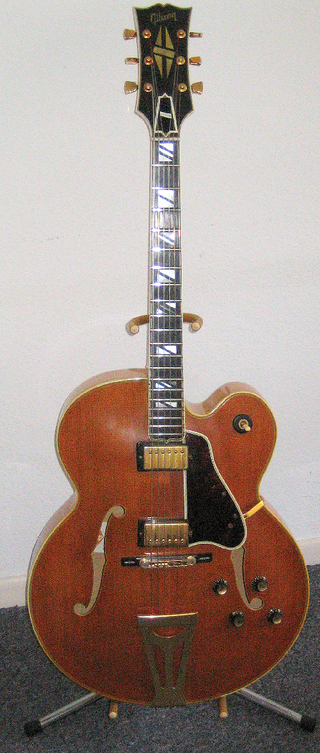
An archtop guitar is a hollow acoustic or semi-acoustic guitar with a full body and a distinctive arched top, whose sound is particularly popular with jazz, blues, and rockabilly players.
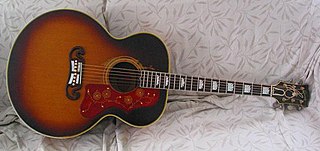
The Gibson J-200, is an acoustic guitar model produced by the Gibson Guitar Corporation.
The Gibson L5S is a solid-body electric guitar model produced by the Gibson Guitar Corporation.

"Cross Road Blues" is a song written by the American blues artist Robert Johnson. He performed it as a solo piece with his vocal and acoustic slide guitar in the Delta blues-style. The song has become part of the Robert Johnson mythology as referring to the place where he supposedly sold his soul to the Devil in exchange for his musical talent. This is based largely on folklore of the American South that identifies a crossroads as the site where such pacts are made, although the lyrics do not contain any references to Satan or a Faustian bargain.

The Epiphone Texan is an acoustic flattop guitar of the (advanced) Jumbo type. Recent models have an integrated light-weight internal electric pickup fitted; the original model was acoustic only.
The Gibson ES series of semi-acoustic guitars are manufactured by the Gibson Guitar Corporation.
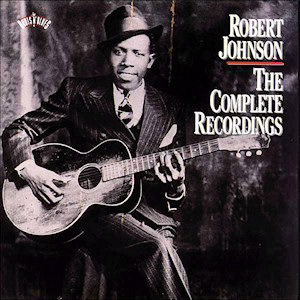
The Complete Recordings is a compilation album by American Delta blues musician Robert Johnson. The 41 songs were recorded in two sessions in Dallas and San Antonio, Texas for the American Record Company (ARC) during 1936 and 1937. Most were first released on 78 rpm records in 1937. The Complete Recordings, released August 28, 1990, by Columbia Records, contains every recording Johnson is known to have made, with the exception of an alternate take of "Travelling Riverside Blues".

Houston Goff, known as Houston Stackhouse, was an American Delta blues guitarist and singer. He is best known for his association with Robert Nighthawk. He was not especially noted as a guitarist or singer, but Nighthawk showed gratitude to Stackhouse, his guitar teacher, by backing him on a number of recordings in the late 1960s. Apart from a brief tour in Europe, Stackhouse confined his performing to the area around the Mississippi Delta.
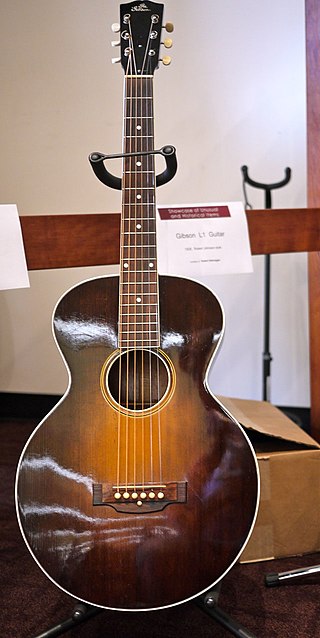
The Gibson L-1 is an acoustic guitar that was first sold by the Gibson Guitar Corporation in the early 20th century. The L-1 model was introduced first as an archtop (1902), and later as a flat top in 1926. The model is famously associated with the legendary bluesman Robert Johnson.

American blues musician Robert Johnson (1911–1938) recorded 29 songs during his brief career. A total of 59 performances, including alternate takes, were recorded over a period of five days at two makeshift recording studios in Texas. Producers selected 25, which Vocalion Records issued on 12 two-sided 78 rpm record singles between 1937 and 1939. These went out-of-print, but were the only source of Johnson's work until his recordings were eventually issued on albums beginning in 1959. In addition to those on the original singles, another 17 recordings have been released.

Grimshaw Guitars was a British manufacturer of guitars and related instruments from the 1930s to the 1980s, known for producing acoustic archtop guitars in the 1930s–1940s, electrified archtop guitars in the 1940s and 1950s, semi-solid (thinline) electric guitars in the 1950s–1960s, and mainly solidbody guitars from the late 1950s to 1980s, along with smaller quantities of banjos, hawaiian guitars, electric bass guitars, acoustic guitars and nylon string guitars. Their archtop guitars were used by British players from the 1930s to the 1950s, when equivalent U.S.-made instruments were difficult to obtain in Britain, and their early electric thinline instruments such as the "S.S.1" and "S.S.1 deluxe" were popular with British "beat" groups of the early 1960s. Sales declined in the later 1960s and 1970s with easier access by customers to better made U.S. instruments at one end of the scale, and cheaper imported instruments, mostly from Japan, with which the Grimshaw line could not compete on price. The Grimshaw factory closed in the mid 1980s and its junior partner founder, Emile Grimshaw Jnr, passed away in 1987. Since that time, surviving instruments occasionally appear on the used market but tend to be somewhat overshadowed in favour of better known instruments of similar age by other British manufacturers such as Burns, Vox, etc.




















